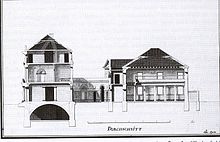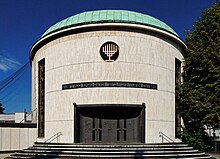Synagogues in Düsseldorf
The history of Jewish places of prayer and assembly in Düsseldorf that we know today begins with the mention of a prayer room in 1712 and extends to today's synagogue , the New Synagogue , which was built in the 1950s based on a design by the Frankfurt architect Hermann Zvi Guttmann .
history
A first prayer hall existed from 1712 in the newly built building of the court factor Joseph Jacob van Geldern , in today's Hubertus-Stift outside the city fortifications, which enclosed the old town and Carlstadt, in Unterbilk, Neusser Straße 25. Joseph Jacob van Geldern was the agent of the electoral court chamber at the court of Johann Wilhelm von der Pfalz . On June 14, 1712, he had given permission to build “a house and Jewish school” on Neusser Strasse with the dimensions “length 316 feet, width 136 feet” . The prayer room in this building was confiscated in 1758. The building on Neusser Straße was sold to the Hubertus-Stift in 1772. The following prayer rooms, now in the area of the old town, can be proven:
- 1772 to 1766 on the Hunsückenstrasse
- 1766 to 1792 on Neustraße in Villers'schen Haus
After the acquisition of the properties at Casernenstrasse 17 and 19 in the area of the former barracks at the end of the 18th century, the old synagogue was built there. The basic designs for the building were created by Peter Joseph Krahe . Master builder Köhler built the synagogue between 1790 and 1792 on the basis of these designs. Due to the influx of many new parishioners, the synagogue had to be converted from 1873 to 1875 in order to enlarge it. The expansion was carried out in the Moorish style according to the designs of Franz Deckers together with Kuhne.
From 1875 to 1907 the Jewish community of Gerresheims had its house of worship on today's Synagogenweg. A memorial stone standing there reminds of the building, which was under monument protection at the time, which fell victim to an arson attack on February 25, 1984 (not 1985, as the memorial stone says) . Shortly beforehand, the youth association had proposed the historical synagogue as a memorial , which was also supported by the citizens' initiative “Memorial for the Victims of the Nazi Regime ”. The remaining ruins were demolished in 1987 as part of the renovation of the town center .
The Great Synagogue at Kasernenstrasse 67 in Düsseldorf was built in 1903 according to the designs of Josef Kleesattel in the neo-Romanesque style. The inauguration took place in 1904. The Orthodox Jews, who refused to build a new church because of the built-in organ, held their services from 1904 in the building at 37 Bilker Strasse and later at 4 Poststrasse.
On November 10, 1938, the Great Synagogue was set on fire as part of the November pogroms and the ruins were demolished on the 29th of the same month.
The Jewish community of Düsseldorf, which only consisted of a few members after the Holocaust , used the large conference room of the Düsseldorf Higher Regional Court for its services from 1945 and a room in Arnoldstrasse 6 in Düsseldorf-Pempelfort from 1948 .
From 1953 the plan was developed to build a new synagogue. On September 7, 1958, the New Synagogue in Düsseldorf-Golzheim on Zietenstrasse was inaugurated in the presence of Prime Minister Franz Meyers .
See also
- Jews in Düsseldorf
- Old Synagogue (Düsseldorf)
- Hubertus pen
- Great Synagogue (Düsseldorf)
- New Synagogue (Düsseldorf)
- Nelly Sachs House
- Cemetery hall and memorial of the Jewish community, Düsseldorf
Individual evidence
- ↑ http://www.duesseldorf.de/stadtarchiv/stadtgeschichte/zeitzeile/zeitbrett_04_1700_bis_1800/index.shtml
- ↑ Düsseldorfer Geschichtsverein, in: Festschrift for the 600th anniversary in 1888 , p. [254] 237.
- ↑ Brief description of the history of the Jewish community in Düsseldorf on the website of the Jewish community in Düsseldorf ( memento of the original from November 27, 2010 in the Internet Archive ) Info: The archive link has been inserted automatically and has not yet been checked. Please check the original and archive link according to the instructions and then remove this notice. .
- ↑ Düsseldorfer Geschichtsverein, in: Festschrift for the 600th anniversary in 1888 , p. [253] 236.
- ↑ H. Ferber; In Historical walk through the old city of Düsseldorf ; Published by the Düsseldorfer Geschichtsverein; Verlag C. Kraus, 1889, Part II, pp. 99, 100.
- ↑ H.Ferber; In Historical walk through the old city of Düsseldorf ; Published by the Düsseldorfer Geschichtsverein; Verlag C. Kraus, 1889, Part II, p. 100
- ↑ Archived copy ( memento of the original from October 29, 2011 in the Internet Archive ) Info: The archive link was inserted automatically and has not yet been checked. Please check the original and archive link according to the instructions and then remove this notice.
- ↑ http://www.gedenkstaettenforum.de/nc/gedenkstaetten-rundbrief/rundbrief/news/vom_ort_des_terrors_zur_gedenkstaette/
Remarks
- ↑ Where the prayer room for the Düsseldorf area was between 1758 and 1772, and a prayer room can be found in the old town from 1772, this needs to be clarified
literature
- Carol Herselle Krinsky: Europe's synagogues. Architecture, history and meaning . Fourier, Wiesbaden 1997, ISBN 3-925037-89-6 . Pp. 40, 48, 80, 97, 98, 412.
- Barbara Suchy with the collaboration of Ulrich Knufinke: Synagogues in Düsseldorf. From 1712 to the present , Ed. Förderkreis der Mahn- und Gedenkstätte Düsseldorf eV in cooperation with the Jewish community Düsseldorf, Small series of the Mahn- und Gedenkstätte Düsseldorf Volume 3, Droste Verlag, Düsseldorf 2013, 64 pp.


